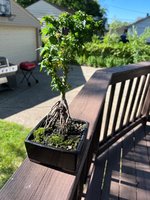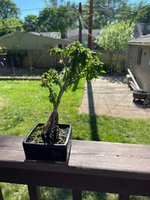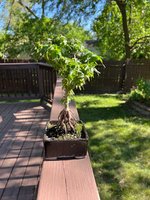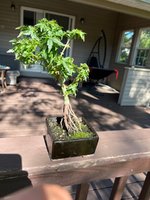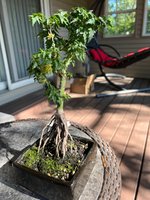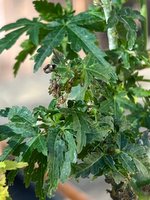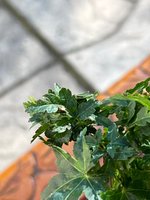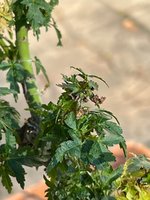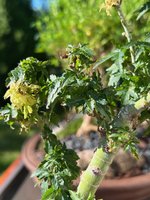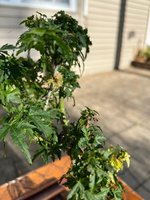tpdietz
Seed
Hi all!
First post! I am new to these forums and the hobby of Bonsai. I have recently acquired (what I believe to be) a koto hime Japanese maple. I don't have a clue how old it is, if its healthy, or really how to care for it...and I suppose that's why I am here. I have done quite a bit of research online before joining this forum and posting this thread, but still don't have a firm grasp on what I can do to ensure a big bright future for my new tree.
Questions I have:
1. Can anyone guess how old this tree is? I suppose that does not really matter, but when searching online for my species of tree I don't really see many that look quite like mine. Specifically, the green-ness of the trunk.
2. Do you think this tree appears healthy? I see some minor yellowing (and even some very small dark spots), which I'm not sure is normal. Are these potentially early indicators of a problem?
3. Does this need to be outdoors all the time? I've heard from someone working at my local greenhouse that this is an outdoor bonsai. However googling this question leads me to believe you can do either.
4. Is this pot too small? I've seen bonsai root balls, and they've seemed much larger than I could have ever anticipated. This pot seems rather small, but I am somewhat worried about trying to repot when I don't know much.
5. Do you have any links/videos/resources that lead to more descriptive care about the koto hime? Most websites I've seen give very basic information that seems incomplete. For example, the first 5 links I found on google when searching "kotohime bonsai maple indoor" don't indicate at all whether or not to place this plant inside or outside...this leads me to believe the websites I'm coming across aren't very good.
6. Do you see any branches or other unsightly oddities you'd recommend I remove now for a better future? I know this is subjective, but I'd really like to hear your opinion if you have one. I'm lost and any information at this stage is extremely helpful.
Thank you for your time! If you have any information to share about your experience with this beautiful tree, I'd love to hear about it
Best,
Troy
First post! I am new to these forums and the hobby of Bonsai. I have recently acquired (what I believe to be) a koto hime Japanese maple. I don't have a clue how old it is, if its healthy, or really how to care for it...and I suppose that's why I am here. I have done quite a bit of research online before joining this forum and posting this thread, but still don't have a firm grasp on what I can do to ensure a big bright future for my new tree.
Questions I have:
1. Can anyone guess how old this tree is? I suppose that does not really matter, but when searching online for my species of tree I don't really see many that look quite like mine. Specifically, the green-ness of the trunk.
2. Do you think this tree appears healthy? I see some minor yellowing (and even some very small dark spots), which I'm not sure is normal. Are these potentially early indicators of a problem?
3. Does this need to be outdoors all the time? I've heard from someone working at my local greenhouse that this is an outdoor bonsai. However googling this question leads me to believe you can do either.
4. Is this pot too small? I've seen bonsai root balls, and they've seemed much larger than I could have ever anticipated. This pot seems rather small, but I am somewhat worried about trying to repot when I don't know much.
5. Do you have any links/videos/resources that lead to more descriptive care about the koto hime? Most websites I've seen give very basic information that seems incomplete. For example, the first 5 links I found on google when searching "kotohime bonsai maple indoor" don't indicate at all whether or not to place this plant inside or outside...this leads me to believe the websites I'm coming across aren't very good.
6. Do you see any branches or other unsightly oddities you'd recommend I remove now for a better future? I know this is subjective, but I'd really like to hear your opinion if you have one. I'm lost and any information at this stage is extremely helpful.
Thank you for your time! If you have any information to share about your experience with this beautiful tree, I'd love to hear about it
Best,
Troy

